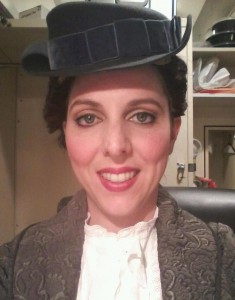Une Voyageuse Fabuleux
The Charles Theater is presenting The Metropolitan Opera’s live HD broadcast of Massenet’s Manon tomorrow & I’ll be on hand to greet audience members, hand out “swag”, & enjoy the show. Not a bad way to spend a Saturday, right? It gets better. Sara Stewart, a wonderful, talented woman who’s a member of the Met’s regular chorus – & a longtime friend of Jim’s & mine – has a solo in this opera.
We first met Sara during Young Victorian Theatre Company’s 2001 production of H.M.S. Pinafore. If you saw that show, Sara was Josephine, I was Cousin Hebe, & Jim was The Handsome  Dark-Haired Guy in the Chorus. Jim & I know a lot of extremely talented singers, but even so, Sara’s voice always impressed us. We’re all too aware that there are no guarantees in any business, especially in the arts, yet we (& many others) had a feeling she’d go on to do great things.
Dark-Haired Guy in the Chorus. Jim & I know a lot of extremely talented singers, but even so, Sara’s voice always impressed us. We’re all too aware that there are no guarantees in any business, especially in the arts, yet we (& many others) had a feeling she’d go on to do great things.
From 2002-2009, Sara & I sang in the Baltimore Opera Chorus together; she also had several small roles with the company during that time. In 2009, Baltimore Opera went bankrupt, which was devastating to everyone who’d worked there, both artistically & financially, but far more so to someone at Sara’s level.
In 2010, Sara announced that she’d auditioned for the regular chorus at the Metropolitan Opera… & that she’d gotten the job! To put this in perspective: if you’re a professional opera chorister, the Met is the best gig in the country. It’s the only company I know of at which such work pays enough to make a living – no office job, teaching, retail, or restaurant work required. Compensation aside, hello, it’s the Met.
Once a season, the Met, like other professional companies, has auditions for chorus members who wish to be considered for small roles. The character Sara is portraying in Manon is referred to simply as “Une Voyageuse” in the score, but Ms. Stewart, with the sense of humor I recall so well from our many productions together, has re-named her “La Voyageuse avec les Oiseaux Morts.” Apparently the props department has given her a birdcage to tote around the stage & its fine, feathered inhabitants are on their backs at the bottom of said cage. I do hope the “deceased” critters are clearly visible on the big screen tomorrow!
Singing in the Met Chorus is nice work if you can get it, true, but it’s also hard work, & the schedule can be somewhat erratic. One’s workload during a given week depends largely on casting. No chorus member sings in every show that happens in the season. Some operas have no chorus, others just men, others a smaller chorus. The small chorus operas get divided up among the regular choristers so that the work/pay is fairly close to even. Staging rehearsals typically begin at 10 or 10:30AM, with more music or staging work possible in the afternoon; the rehearsal day typically ends around 5PM. If a singer is in rehearsal for one show & simultaneously performing in another, which is not uncommon, they will need to be back at the theater around 7PM. The Met presents 7 performances a week, Monday through Friday and two on Saturday; there are usually four productions running concurrently. In Sara’s words, “Bottom line, it takes a master’s degree just to understand the schedule!”
Bravissima, Sara; we are so proud of you & can’t wait to catch your performance on the big screen tomorrow! For those who are planning to join us at The Charles, we’ll be there at 11AM; the opera begins at 12 Noon.
Tags:Anna Netrebko, Charles Theater, Fabio Luisi, Laurent Pelly, Lyric Opera Baltimore, Manon, Massenet, Metropolitan Opera, new york, opera, Paulo Szot, Peabody Institute, Piotr Beczala, Sara Stewart, singer, Soprano




